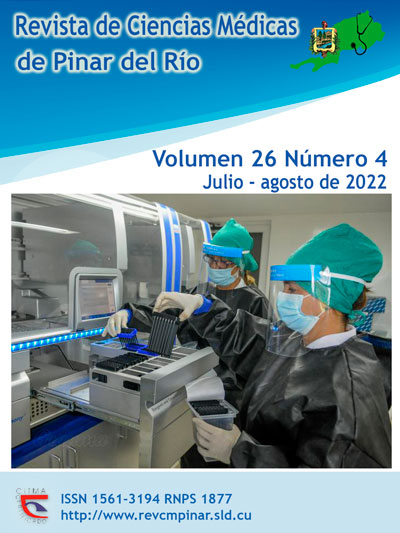Characterization of pregnant women with venous thromboembolic disease attended at the General Teaching Hospital "Abel SantamaríaCuadrado".
Keywords:
VENOUS THROMBOEMBOLISM, VENOUS THROMBOSIS, THROMBOSIS, VASCULAR DISEASES, PREGNANCY COMPLICATIONS, CARDIOVASCULAR.Abstract
Introduction: venous thromboembolic disease constitutes one of the complications of pregnancy, which can evolve torpidly and cause death.
Objective: to characterize pregnant women with venous thromboembolic disease attended at the "Abel SantamaríaCuadrado" General Teaching Hospital.
Methods: an observational, descriptive and cross-sectional study was conducted in pregnant women attended at the "Abel SantamaríaCuadrado" General Teaching Hospital between May 2018 and March 2021. The sample consisted of 26 patients. Descriptive statistics were used.
Results: 0,09 % of the 27,500 pregnant women attended presented venous thromboembolic disease, with a higher incidence in the age group of pregnant women aged 35 years or older (0,06 %). A total of 76,92% developed venous thromboembolic disease during the puerperium, with the highest incidence during the puerperium being observed in patients who underwent cesarean section (80%). Of the patients with venous thromboembolic disease during pregnancy, 57,69% presented varicose veins in the lower limbs and 69,23% reported a history of deep vein thrombosis. Venous thromboembolic disease was common (57,69 %) in pregnant women with a body mass index greater than 28,6.
Conclusions: Venous thromboembolism presented a low incidence, which was higher during the puerperium, occurring commonly at that stage in those who had to undergo cesarean section. In pregnant women with a history of deep vein thrombosis, recurrence was common. Venous thromboembolic disease was more frequent in pregnant women with a high body mass index.
Downloads
References
1. Chan WS, Ray JG, Murray S, Coady GE, Coates G, Ginsberg JS. Suspected pulmonary embolism in pregnancy: Clinical presentation, results of lung scanning, and subsequent maternal and pediatric outcomes. ArchInternMed [Internet]. 2002 [citado 12/12/2021]; 162(10):1170-5. Disponible en: https://doi.org/10.1001/archinte.162.10.1170
2. EraslanSahin M, Col Madendag I. A critical analysis of prophylaxis to avoid venous thromboembolism after cesarean delivery. AnnalsMed Res [Internet]. 2019 [citado 12/12/2021]; 26(11):2648-52. Disponible en: http://www.annalsmedres.org/articles/2019/volume26/issue11/2648-2652.pdf
3. Irigoín Victoria, Lorenzo Mariana, Grille Sofía, González Valentín. Enfermedad Tromboembólica Venosa en el período grávido puerperal. Diagnóstico, tratamiento y profilaxis. Rev. Urug. Med. Interna [Internet]. 2021 Jun [citado 12/12/2021]; (2): 7-21. Disponible en: http://dx.doi.org/10.26445/06.02.1
4. Fernández A, Castelli J, Álvez I. Estudio sobre la prescripción de profilaxis de enfermedad tromboembólica en la embarazada. Salud Mil [Internet]. 2021 [citado 12/12/2021];40(1):25-0. Disponible en: http://revistasaludmilitar.uy/ojs/index.php/Rsm/article/view/167
5. Naidoo P, Mothilal R, Snyman LC. Assessment and management of venous thromboembolism risk during pregnancy and the puerperium (SAVE): the South African cohort. S AfrMed J [Internet]. 2019 [citado 12/12/2021]; 109(3):[aprox 20 pp]. Disponible en: https://journals.co.za/doi/abs/10.7196/SAMJ.2019.v109i3.13487
6. Dirección de Registros Médicos. Anuario estadístico del MINSAP. La Habana [internet]. 2020 [citado 10/04/2021]. Disponible en: https://temas.sld.cu/estadisticassalud/
7. Sultan AA, West J, Tata LJ, et al. Risk of first venous thromboembolism in and around pregnancy: a population-based cohort study. British Journal of Haematology [Internet]. 2012 [citado 10/04/2021]; 156:366-373. Disponible en: https://onlinelibrary.wiley.com/doi/full/10.1111/j.1365-2141.2011.08956.x
8. Donoso E, Carvajal J. El cambio del perfil epidemiológico de la mortalidad materna en Chile dificultará el cumplimiento del 5° objetivo del milenio. RevMed Chile [Internet]. 2012 [citado 10/04/2021]; 140(10):1253-1262. Disponible en: https://scielo.conicyt.cl/scielo.php?pid=S0034-98872012001000003&script=sci_arttext&tlng=e
9. Kamel H, Navi BB, Sriram N, et al. Risk of a Thrombotic Event after the 6-Week Postpartum Period. N Engl J Med [Internet]. 2014 [citado 10/04/2021]; 370:1307-1315. Disponible en: https://www.nejm.org/doi/full/10.1056/nejmoa1311485
10. Parrila B et al. Diagnosing pulmory embolism in pregnancy: Are biomarkers and clinical predictive models useful?.American Journal of PerinatologyReports. 2016 [citado 10/04/2021]; 06(02): e160-e164. Dsponible en:https://www.thieme-connect.com/products/ejournals/html/10.1055/s-0036-1582136
11. Grillo CF, Mogollón AC, Amaya J, Molano D, Correa LP. Guía de práctica clínica para la prevención de eventos tromboembólicos venosos durante la gestación, el parto o el puerperio. Rev Colombiana de Obstetricia y Ginecología [Internet]. 2017 [citado 10/04/2021]; 68(4):285-304. Disponible en: https://revista.fecolsog.org/index.php/rcog/article/view/3084
12. American College Obstetricians and Gynaecologists. "ACOG practice bulletin No. 196: thromboembolism in pregnancy." Obstetrics and gynecology[Internet]. 2018 [citado 10/04/2021]; 132(1):e1-e17. Disponible en https://pubmed.ncbi.nlm.nih.gov/29939938/
13. Markow C, Main EK. Creating Change at Scale: Quality Improvement Strategies used by the California Maternal Quality Care Collaborative. ObstetGynecolClin North Am [Internet]. 2019 [citado 10/04/2021]; 46(2):317-328. Disponible en: https://www.doi.org/10.1016/j.ogc.2019.01.014
14. Camacho-Torres DM, Arenas YM. Clasificación de riesgo para enfermedad tromboembólica venosa y tromboprofilaxis durante el puerperio, Tunja 2017. Revista Investig. Salud Univ. Boyacá [Internet]. 2020 [citado 10/04/2021];7(1):19-34. Disponible en: https://revistasdigitales.uniboyaca.edu.co/index.php/rs/article/view/296
15. Silva-Reyna Paola. Enfermedad tromboembólica venosa en el embarazo. Rev. mex. anestesiol. [Internet]. 2020 [citado 10/04/2021]; 43(1): 41-47. Disponible en: http://www.scielo.org.mx/scielo.php?script=sci_arttext&pid=S0484-79032020000100041&lng=es
16. Mendonça MMV, Santos AC de F, Mendes ACR, Guimarães BA, Ribeiro GA, Andrade IA de, Potsch LS, Jesus LS de, Nicolau LFM, Parreira MLBQC. A incidência de tromboembolismo venoso em gestantes e no puerpério e seusfatores de risco. REAC [Internet]. 2021 [citado 10/04/2021];30:e8125. Disponible en: https://acervomais.com.br/index.php/cientifico/article/view/8125
Downloads
Published
How to Cite
Issue
Section
License
Authors who have publications with this journal agree to the following terms: Authors will retain their copyrights and grant the journal the right of first publication of their work, which will be publication of their work, which will be simultaneously subject to the Creative Commons Attribution License (CC-BY-NC 4.0) that allows third parties to share the work as long as its author and first publication in this journal are indicated.
Authors may adopt other non-exclusive license agreements for distribution of the published version of the work (e.g.: deposit it in an institutional telematic archive or publish it in a volume). Likewise, and according to the recommendations of the Medical Sciences Editorial (ECIMED), authors must declare in each article their contribution according to the CRediT taxonomy (contributor roles). This taxonomy includes 14 roles, which can be used to represent the tasks typically performed by contributors in scientific academic production. It should be consulted in monograph) whenever initial publication in this journal is indicated. Authors are allowed and encouraged to disseminate their work through the Internet (e.g., in institutional telematic archives or on their web page) before and during the submission process, which may produce interesting exchanges and increase citations of the published work. (See The effect of open access). https://casrai.org/credit/



